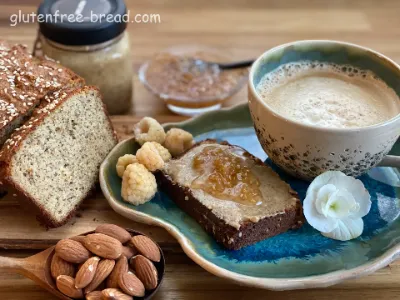Additional info
Gluten-free almond flour bread is a popular alternative to traditional wheat bread for those with gluten sensitivities or celiac disease. Here’s a detailed description of this type of bread:
Ingredients
- Almond Flour: The main ingredient, made from finely ground almonds, gives the bread a slightly nutty flavor and a dense texture.
- Eggs: Often used to provide structure and leavening, helping the bread rise and hold together.
- Baking Powder or Baking Soda: Used as a leavening agent to help the bread rise.
- Salt: Enhances the flavor.
- Oil or Butter: Adds moisture and richness. Common choices include olive oil, coconut oil, or melted butter.
- Sweetener (optional): Some recipes include honey, maple syrup, or a sugar substitute to add a touch of sweetness.
- Vinegar or Lemon Juice (optional): Helps react with the baking soda to improve the rise and texture.
Texture and Flavor
- Texture: Almond flour bread tends to be denser than traditional wheat bread due to the absence of gluten. It has a moist and slightly crumbly texture.
- Flavor: It has a mildly sweet, nutty flavor from the almonds, which can be complemented by the added ingredients like honey or herbs.
Nutritional Benefits
- Gluten-Free: Safe for people with celiac disease or gluten sensitivity.
- Low Carb: Suitable for low-carb and ketogenic diets as it is typically lower in carbohydrates compared to wheat bread.
- High in Healthy Fats: Almond flour is rich in monounsaturated fats, which are beneficial for heart health.
- Protein-Rich: Contains more protein than traditional bread, which can help with satiety.
- Vitamins and Minerals: Almond flour is a good source of vitamin E, magnesium, and fiber.
Uses
- Sandwiches: While denser, it can still be sliced and used for sandwiches.
- Toast: Makes excellent toast, especially when topped with avocado, nut butter, or other spreads.
- Snacking: Can be eaten on its own or with dips and toppings.
Storage
- Room Temperature: Can be stored at room temperature for a few days.
- Refrigeration: Stays fresh longer when refrigerated, usually up to a week.
- Freezing: Can be frozen for extended storage. Slices should be separated by parchment paper and stored in an airtight container or bag.
Variations
- Savory: Herbs, seeds, or cheese can be added for a savory twist.
- Sweet: Incorporate ingredients like dried fruits, chocolate chips, or spices like cinnamon









